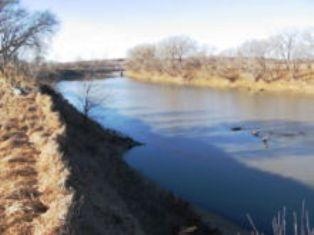Big Blue River Fishing Spot
- Elevation: 1142'
- Last Modified By: vinny60 on 09/08/09 06:17 PM
- Ask about Big Blue River in our Fishing Forums
Photos

Fish Species
Comments
-
Have you fished at Big Blue River? Be the first to comment on this fishing spot.
Big Blue River Description
The Big Blue River is the largest tributary of the Kansas River. The river flows for approximately 250 miles (402 km) from central Nebraska into Kansas. It was named by the Kansa tribe of Native Americans, who camped at its mouth. The river passes through mostly agricultural land. Shortly before intersecting with the Kansas River, the Big Blue discharges its waters into a reservoir called Tuttle Creek Lake, which lies slightly northeast of Manhattan, Kansas. The reservoir is a manmade flood-control measure, held back by a dam composed of the limestone, silt, and gypsum dredged out of the floodplain by bulldozers left to rust underneath the flooded area. It is a state park area, although the Great Flood of 1993 decimated much of the northern area. The river continues as the outflow from Tuttle Creek Lake for approximately five miles before intersecting with the Kansas River east of Manhattan. To reach the Big Blue River Trail from Manhattan, head east on US 24 about 1.5 miles. The parking area is on the right (south) side of US 24, just before you go over the bridge. There is a small sign for the Big Blue River and Linear Trail Park. You can access the Big Blue River here by boat or canoe using the ramp provided. This trail is set up for mountain biking with ramps are provided at intervals along its length. If you choose to go mountain biking here keep in mind that the trail is somewhat difficult and secluded.
The Big Blue River is the largest tributary of the Kansas River. The river flows for approximately 250 miles (402 km) from central Nebraska into Kansas, where it intersects with the Kansas River east of Manhattan, Kansas. It was given its name by the Kansa tribe of Native Americans, who camped at its mouth from 1780 to 1830.